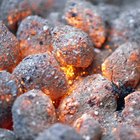There are three ways in which heat can move: convection, conduction, and radiation. Each of these relate to a vacuum in its own way, so it's important to take account of all three when considering how heat moves (or doesn't move) in a vacuum.
Heat
At the molecular level, heat is the result of the energy that a substance possesses from the motion of its molecules. The faster the molecules move, the hotter the substance. In fact, at the raw physical level it makes more sense to think of a substance having internal energy, as opposed to heat, and consider heat only when that energy is transferred to another substance.
Conduction
Conduction is normally what we think of as the transfer of heat. The fast moving molecules of the hot part of the substance collide with the slow moving particles of the cold part of the substance, and this causes them to speed up and become hotter. A clear example is a metal rod being heated at one end: conduction will cause the entire rod to become hot. Since there are no particles within a vacuum for the molecules of a substance to collide with, heat transfer via conduction is impossible through a perfect vacuum.
Convection
Convection occurs in a moving substance such as air or water. A source of heat (such as a heater in a home) heats the air around it and blows it out into the room. As it flows out into the room, it rises and pushes colder air down and back to the heater. This cool arm is warmed and the process repeats. Since there's no substance in a vacuum to move, heat transfer through a perfect vacuum via convection is impossible.
Radiation
The spread of electromagnetic waves such as light can carry heat with them. For example, the heat of the sun gives off light. The light of the sun travels through space and hits the earth's atmosphere. Some of these light waves strike molecules of air and cause them to speed up. Since heat is just the motion of the molecules within a substance, this is the same as saying the air is heated. And, since electromagnetic waves are not impeded by a vacuum, heat can be transfer through a vacuum via radiation.
Related Articles

Example of Passive Solar Energy

How Does Infrared Cooking Work?

The Purpose of a Heat Exchanger

Parts of a Hair Dryer

Can You Pour Boiling Water Into a ...

Heating Foods in Plastic & BPA

What Does Rennet Do in Ice Cream?

Heat Rash and Hot Yoga

How to Use Bathtub Jacuzzi Jets

How to Cook With Radiant Heat

Uses of Thermal Insulators

How Does Cotton Help Insulate?
Convection Broiling Vs. Convection ...

What Is the Difference Between Wet & ...

The Best Temperature for Wax Hair ...

Are Halogen Heat & Infrared Waves Safe ...

How to Use a ReliOn Humidifier

What Is a Substitute for Lighter Fluid?

How to Cook a Rib Eye Steak in a Glass ...

How Does Ultraviolet Light Affect ...
References
Writer Bio
Kevin Walker is a computer programmer who decided to take a few years out from the corporate life and see the world. He spent a total of six years living abroad and teaching English in China, Korea and Mexico before returning to his home in Texas. He uses his programming and teaching experience to write easy-to-understand computer tutorials.